It is intriguing that one of the great modern masters of American equitation came from one of the oldest and most traditional of equestrian milieu – the European Cavalry. De Némethy was born in Gyor, Hungary in 1911. His father governed three of Hungary’s 19 states, and young Bertalan was raised in the Governor’s mansion and educated by Benedictine monks.
Bertalan de Nemethy on Adam II in Vienna, Austria, 1939
Encouraged by his horseman uncle, de Némethy fell in love with the sport of showjumping, and it was to pursue this love that he enrolled in the military academy of Ludovica. He spent four years at the Ludovica Academy, graduating in 1932 as a lieutenant in the cavalry assigned to the Hussars of the Count of Nadassy.
After four years of service he was selected to attend the Hungarian cavalry school. The officer/students rode six horses a day, starting on dressage horses, riding on the longe line without stirrups, later going cross-country on young horses.
“Today there is no such way – I shall call it ‘classical’ – for anybody to be sent to learn, because it doesn’t exist any more. There are no specially educated teachers to observe. I rode hundreds and hundreds of horses for two years, riding many hours without stirrups and working with many different instructors. Today there is no one with so much experience on a horse,” he told Paula Rodenas, the author of The de Némethy Years.
De Némethy graduated in 1937 and was asked to stay on and teach. He also became a member of the four rider Nations Cup team and commenced training for the 1940 Olympic Games – the Games that were never held because of the outbreak of the Second World War.
De Némethy was the first Hungarian officer to be sent to the German cavalry school of Hanover, where he rode with such luminaries as Fritz Stecken, Bubbi Gunther and Otto Lörke, who was in charge of the dressage stable. With the Russian Army closing in on Budapest towards the end of the war, de Némethy fled to Denmark, and he taught in Copenhagen for the next six years.
In 1952 he accepted the offer of relocation to the United States, and started teaching at the Sleepy Hollow Country Club, Tarrytown, New York, where he made friends with several top riders, including William Steinkraus. De Némethy was offered the position as USET jumping coach, and eventually took up the position in 1955.
In an interview with American equestrian journalist, Nancy Jaffer, de Némethy remembered what he encountered when he took over that rough-around-the-edges show jumping squad.
“They were not sitting backwards on their horses,” he said with a sly smile. “But they had no dressage preparation. It was not fashionable or known at that time. They were experienced in hunter classes primarily.”
Kathy Kusner and Untouchable at the 1960 Games – Kathy came from riding for a horse dealer but soon became a star pupil – “The girls showed they could be not only equal, but better.” Photo – Werner Ernst
USET member Chrystine Jones Tauber, who took over the Gladstone centre and worked as director of show jumping activities after de Nemethy’s 1980 retirement, noted that he showed the Americans ‘the value of having a system’. He felt that without basic dressage and cavalletti, horses wouldn’t perform up to their potential.
She recalled his emphasis on drilling riders on the lunge line without stirrups or reins. The favourite horse for that exercise was Royal Beaver, a retired eventing mount, who clomped around without the finesse or lightness that de Némethy urged his riders to elicit from the gelding.
“You’d be squeezing ‘til your legs were numb,” said Tauber. “You could hardly walk the next day.” But she thinks those lessons paid off in a uniformity of style and the excellent seat that became the American trademark.
Before going on to win his individual gold medal at Mexico City in 1968, William Steinkraus spent half an hour on the lunge!
It was Steinkraus who pointed out last month, that he looked to a synthesis of the French and the German approaches, and it seems that de Némethy did much the same.
In his Classic Show Jumping: The de Némethy Method he cites both the German master, Steinbrecht and the French maitre, L’Hotte as the source of his basic principles:
“Gustav Steinbrecht, who is still regarded by many as the greatest German master of equestrian art, offered a simple summation of the basic principles of riding: ‘Ride your horse forward, and keep it straight.’ The famous French general, L’Hotte agreed, but found it necessary to rank calmness even ahead of the other concepts; his own motto was ‘calm, forward and straight.’ Both concepts are intertwined.
“We must remember that the two concepts, riding forward and making the horse straight, are in fact interrelated. In other words, the horse will resist the demand for forward obedience if it is not straight within its body position, for, if it is crooked, the harmonious, flowing forward movement will be disturbed. Indeed, resistance usually originates due either to crookedness, or mental or temperamental difficulties. On the other hand, keeping the body straight in the absence of any willingness to move forward is hardly possible. Consequently, before deciding which of the two basic principles should receive priority, we must consider their basic definitions and analyse the feelings linked to them.”
So sitting in the saddle how do we know when our horse is straight?
“When one sits evenly on both seat bones, keeping one’s hipbones naturally straight above them, the lower legs remain in the same position on both sides. We can feel and see the horse’s shoulders moving evenly and parallel to each other. Its neck is straight and directly in front of the middle of our body. Its ears are even, and we can barely see its eyebrows. Our contact with its mouth is the same on both sides.”
And the reverse?
“What feeling do we get when we are sitting on a horse that is crooked in its body? If one of the hind legs deviates, we should immediately feel it through our seat. The deviating hind leg pushes and transfers more weight to the opposite shoulder and, accordingly, pushes our seat to that side. The horse’s neck bends in the direction of the deviating hind leg, and the body becomes hollow – or bent – to a certain degree on that side. The horse tries to find support in our opposite hand by stiffening its jaw, and, if it can find that support, by adding weight to it. On the opposite side, the ribs are curved outwardly, indicating that our leg is not accepted and, indeed, is being thrown away. In essence, the whole direction of the movement inclines towards the side to which weight was transferred by the deviating hind leg.”
Ever listened to badly trained showjumping horses in action? Listen, don’t watch, and you hear the lack of rhythm, the footfalls are all over the place. Why? The horse is not forward.
“Liveliness and impulsion are both components of forward obedience, and neither should ever be confused with mere nervousness, the criterion being that the horse’s regularity of movement must remain undisturbed. However, liveliness cannot be separated from impulsion, the latter being partly natural and a result of innate temperament, and partly something that is developed through proper training.”
Frank Chapot was for many years a key member of the American showjumping team. Here he is riding San Lucas at the Mexico Olympics. “The thing that Bert always had was a lot of class,” said Chapot, “He was always a gentleman and could deal with horse owners and team members, even if they were difficult and demanding. He never lost his cool.” Photo – Werner Ernst
The next, and more complex concept is that of Balance. First we must find the horse’s centre of gravity:
“It is at the level of the sixth rib, just behind the point of the elbow and about two thirds of the way down from the top line along its back. Alternatively, if one makes a vertical line from behind the withers, and a horizontal line from the shoulder point to the buttock, the point at which these two imaginary lines cross each other in the body of the horse would also be the centre of gravity.”
“Maintaining the horse’s natural balance is of primary importance in riding. This in turn depends on the rider’s ability to bring his own centre of gravity into synchrony with that of the horse. The rider’s position, as well as his weight, must be adjusted to the horse’s movements; usually by the rider placing his body directly above or ahead of the horse’s centre of gravity, depending on the horse’s velocity.”
In other words, the faster the horse is going, the further forward the upper body of the rider goes, but never so much that the rider’s centre of gravity is in front of the horse’s.
But balance involves more than the positioning of the rider’s body, “the horse’s natural balance can be maintained only if its weight is evenly distributed between its right and left pair of legs, as well as between the forelegs and hind legs. When the horse’s hindquarters are more engaged by the rider’s influence, and its hind legs reach closer to the centre of gravity line under its body, its hindquarters will sink, its centre of gravity will move back, and its forehand will thus become somewhat relieved of carrying the added weight.”
Richard Wätjen who studied and worked in the Spanish Riding School, Vienna from 1916-21, before setting up his training centre in Berlin, was another influential figure in the development of American riding, and de Némethy quotes with approval his dictum:
“Balance is the result of impulsion in harmony with collection.”
The next critical factor is rhythm as distinct from cadence:
“Cadence is often confused with rhythm, for the terms are closely related; but there is a subtle shade of difference between the two. The rhythmical movement of the horse is individualized, and depends upon the particular horse’s conformation, size and disposition. The horse’s cadence, on the other hand, can be developed only in a more collected frame: the strides become shorter, the leg action becomes more elevated, and the sequence of the movements becomes slower. Since no horse will remain in its ideal rhythm at any gait instinctively, the rider must use his influence to discover and regulate it. When the rider is finally able to maintain this ideal natural rhythm, the horse’s maximum stability is achieved.”
Mary Mairs first rode for the States at the 1963 Pan American Games on Tomboy. She rode Tomboy at the Tokyo Olympics and is pictured on White Lightening at Mexico. Mary married fellow team member Frank Chapot in 1965. When de Némethy first took his USET team out to the big American shows, they were not taken seriously by the seasoned professionals. “But after we started to win, their attitude changed! They didn’t like to see ‘little girls’ like Mary Mairs and Kathy Kusner beating someone who had been making his living with horses for the past fifteen or twenty years.” Photo – Werner Ernst
De Némethy has been credited with the introduction of gymnastic exercises to the American jumping scene, or at least, their very great refinement, but he is careful to pay tribute to the Italian inventor of the forward seat, Caprilli, in developing these methods:
“His system was uncomplicated. Change the rider’s position; do not disturb the horse’s natural balance; train the horse to take care of itself and yet be disciplined, obedient and confident in its rider. Caprilli was convinced that logical and systematic training was necessary for the jumper. His training area was a country field, and his program involved jumping many low fences from a trot, and trotting over rails on the ground. Eventually he added little feet to the rails to stabilize and slightly raise them, so that they resembled little saw horses, or cavalletti.”
De Némethy’s use of cavalletti in the United States was something of a last ditch measure. He’d been engaged as U.S. Equestrian Team coach in 1955 to prepare them for the Olympics the following year. With such a short time left before the team departed for Europe, de Némethy judged that he could not make ‘drastic’ changes:
“I had to figure out methods which would let them build on what they already knew, while developing techniques that would help them cope with European competitive conditions, which were very different from those they were familiar with from domestic competition. I concluded that if I could find a way to control the horses’ take-off without upsetting their temperaments, I could enable both the horses and riders to practice what they needed to work on. The system of cavalletti to control the take-off, combined with gymnastics could produce exactly the desired result. The method of using cavalletti and gymnastics that I devised and developed through necessity is a very flexible one, and does not need to be applied according to rigid, hard and fast rules. Yet if it is employed intelligently and imaginatively, it can help to solve many different problems, and can almost infallibly help to develop whatever potential ability both the horses and the riders possess, in a shorter period of time than might otherwise be required.”
So if the next time you find yourself sharing an arena with a bunch of poles, cavalletti and little jumps, you know who to blame… What is critical to the success of this exercise is the distances between the poles.
Use of the cavalletti: Bertalan de Némethy on San Lucas in Aachen, Germany 1972. The horse’s legs are in perfect coordination. The hoofprints are in the middle of the poles. The rider’s position is correct. (From The de Némethy Method)
“The normal distances between vary from 4 to 5 feet. Horses of average size usually start with 4 foot six inch to 4 foot nine inch distances. However, after a couple of tries one can observe if some adjustment is necessary, one way or the other, and the spacing can be adjusted to the natural length of the particular horse’s stride.”
The benefits of this exercise are many:
“What is the benefit to the horse of trotting over cavalletti? Our primary goal is to capture the horse’s attention and focus its concentration on the ground. It is an old horse master’s axiom: ‘Show your horse the ground’. Trotting over the cavalletti encourages the horse to stretch its neck down from the shoulder and look where to put its feet. Because it must lift its feet higher over the poles that it would on flat ground, its tendons and muscles – especially those of the hindquarters – become stronger. Furthermore, in concentrating on the ground and stretching its neck, the horse raises its spine and surrounding muscles, thus loosening up its back. In short, the entire musculature of the horse becomes conditioned and relaxed.”
And let us not forget that original last-ditch strategy de Némethy developed for his Stockholm team:
“Since we can control the horse’s impulsion and speed by using four correctly spaced cavalletti, we can also control the correct take-off point for a fence (crossed rails) built after the cavalletti. This fence should be placed nine to ten feet beyond the last cavalletti – twice the distance between any two cavalletti themselves. By controlling the take-off in this way, it will be stabilized and can be practiced over and over, so that the jumping technique of the horse as well as the style of the rider can be corrected and developed.”
The plan is well set out in the diagram from The de Némethy Method shown below.
Take-off and bascule exercises are beneficial for the following purposes: 1) improving the timing in approaching the first cavalletti; 2) the cavalletti makes the horse relaxed and helps it to concentrate on the ground before arriving at the take-off point; 3) the horse instinctively makes a correct bascule over the fence and properly employs its mechanism to lift its weight; 4) the rider can analyze his style over the fence. Note that in altering fences, the rear rail should be raised first; then the fence should be spread, and the front rail raised last.
This is just one of a series of fabulous diagrams setting out a whole host of wonderfully thought out gymnastic exercises. Any serious jumping rider should rush to their website and track down a second hand copy of The de Némethy Method – last time I looked there were a few on Amazon.com.
De Némethy was coach of the USET team for 25 years from 1955 to 1980 and produced teams that could more than hold their own anywhere in the world:
“Bert took us to a whole new dimension of riding and training horses,” said George Morris, “Although he only was involved with the elite level, it filtered down. The top pulled up the rest. It was a perfect recipe. He had a great country to work with, he had great horsemen, and the hunter base prepared horses. He had this diamond in the rough.”
“He was a class person. If you did something wrong, you knew you had to answer to him,” said another of his famous students, Michael Matz. “But he told you, and that was it, and nothing was held against you, and you knew you weren’t going to do it again.”
There was a feeling that de Némethy had a hard time adjusting to female team members. The cavalry squads on which he rode before the war were all male, and the same was true in every other country that competed in team events internationally.
In the early 1970s, Melanie Smith Taylor, a member of the 1984 Olympic gold medal team said, “lady riders were not considered as ‘strong and dependable’ as the men. Therefore, it was much harder for us to make the team. It took many tries for me personally to earn Bert’s confidence. But once we girls proved our mettle, Bert was forever loyal to us.”
When it came to the social activities that once were so much a part of the international show scene, de Némethy laid down the law just as much as he did in the ring.:
“He would tell us, `you girls be in the lobby of the hotel in a half-hour in long gowns with your hair clean,’” said Carol Hofmann Thompson, laughing as she remembered the trauma of three women with one bathroom among them trying to follow those orders.
“He really loved having the girls to show off,” she added. At the same time, he was always devoted to his late wife, Emily, whom he adored. He was never the same after her sudden death in 1997. After his retirement as team coach, de Némethy was in keen demand as a course builder, and advisor to riders all over the United States. His contribution to the development of American – and through that World – showjumping, is unique. As that poet, William Steinkraus puts it, his place in equestrian history is secure: “You couldn’t erase the traditions if you tried. They are part of our collective experience. Even if thirty years from now, people ask ‘Who was Bertalan de Némethy?’ They will still be doing things his way.”
Bertalan de Némethy on Adam II in Munich, Germany, 1939 – everything old is new again…
FOUR SHOWJUMPING MASTERS – Part 1: George Morris
FOUR SHOWJUMPING MASTERS – Part 2: William Steinkraus
FOUR SHOWJUMPING MASTERS: Part 4: Gordon Wright


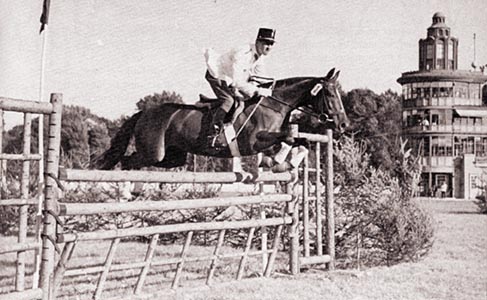
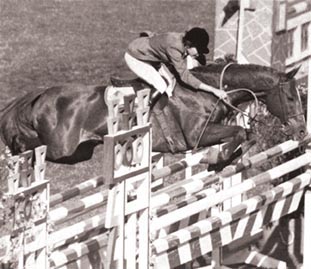

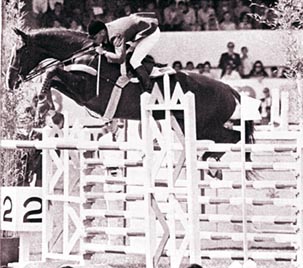
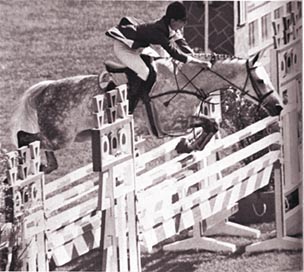
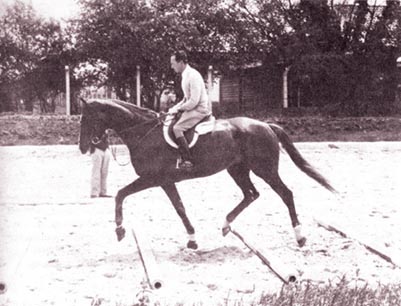

LS.
i met Bertalan in the Netherlands about 20 years ago.He was a gentleman I was very impressed.
Excelente reportaje de este gran maestro…que cambió la equitación moderna y como siempre nadie es profeta en su tierra.
Gran Maestro y que derramo su enseñanza en todo el mundo, hasta hoy.